Go Fish Versus Quake
|
| < Day Day Up > |
|
Do all games share the same exact structure? Of course not. A card game has a very different format than a boardgame; a 3D action game is not at all the same as a trivia game. There is something, however, that they must share, because we clearly recognize them all as 'games.' Take Go Fish and Quake. They must have some similarities because if we asked you if each was a game, you'd say, 'Yes!' In other words, if these games don't share the same structure, then what do they share that makes them games and not two different forms of entertainment?
Before venturing to say what the similarities between them might be, it would help to look more closely at each of the two example games.
Go Fish
This is a game for three to six players using a standard 52-card deck. The dealer deals five cards to each player. The rest of the cards are placed face down in a draw pile. The player to dealer's left starts.
A turn consists of asking a player for a specific rank. For example, if it's your turn, you might say, 'Chris, please give me your Jacks.' You must already hold at least one card of the requested rank, so you must hold at least one Jack to say this. If Chris has cards of the named rank (Jacks in this case), he has to give you all his cards of this rank. You then get another turn and may again ask any player for any rank that you hold.
If Chris does not have any cards of the named rank, he says, 'Go fish!' You must then draw the top card from the draw pile. If the drawn card is the rank you asked for, you show it and get another turn. If the drawn card is not the rank you asked for, you keep it, but the turn now passes to the player who said, 'Go fish!'
As soon as a player collects a book of four cards of the same rank, this must be shown and discarded face down. The game continues until either someone has no cards left in their hand or the draw pile runs out. The winner is the player who then has the most books.
Quake
In single-player Quake, the player controls a character within a 3D environment. Your character can walk, run, jump, swim, shoot, and pick up stuff, but you have a limited amount of armor, health, and ammo.
In the game there are eight types of weapons: axe, shotgun, double-barreled shotgun, nailgun, perforator, grenade launcher, rocket launcher, and a thunderbolt. Each weapon uses a specific type of ammo: shells are for both types of shotguns, nails are for nailguns and perforators, grenades are for grenade launchers and rocket launchers, and cells are for the thunderbolt. There are also power-ups within the game that will boost your power, protect you, heal you, or render you invisible, invulnerable, or able to breathe underwater.
Your enemies include rottweilers, grunts, enforcers, death knights, rotfish, zombies, scrags, ogres, spawn, fiends, vores, shamblers, and possibly other players. Hazards you might find in the environment are explosions, water, slime, lava, traps, and teleporters.
The goal of Quake is to stay alive while you move through the levels. Also, according to the backstory, your overall objective is to find the enemy, codenamed Quake, who is using 'slip- gates' (transporter devices) to insert death squads inside your bases to kill, steal, and kidnap. You have the authority to requisition anything that you need to achieve your objective.
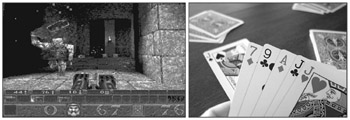
Figure 2.1: Quake and Go Fish
There are four episodes in the game. The first level of each episode ends in a slipgate-these signify that you've entered another dimension. When you complete an entire dimension (five to eight levels), you encounter another slipgate, which returns you to the start.
Comparison
At first glance, the descriptions of these two experiences could not be more dissimilar: one is a turn-based card game; the other is a real-time 3D action shooter. One requires a piece of commercial software and a personal computer capable of running it; the other can be played with a common deck of cards. One is a copyrighted product; the other is a public domain set of rules, which can be transferred verbally from person to person, generation to generation. And yet we call them both games, and agree, even if we cannot at first verbalize it, that they are similar experiences at some deep level.
If we look closely, though, and try not to ignore ideas that seem self-obvious, there are enough similarities between the experience of Quake and the experience of Go Fish for us to begin to understand what underlying requirements we are looking for when we judge whether or not something is a game.
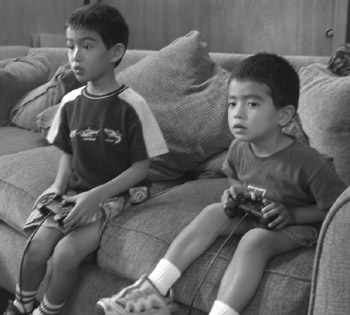
Figure 2.2: Players
Players
The most obvious similarity in these two descriptions is that both start out by mentioning that the experiences are for players. This sounds like a simple distinction, but what other forms of entertainment are designed to demand active participation by their consumers? Sports are one example, but of course, many sports are games. Musicians participate in creating the experience of music, but the primary consumers are the audience, not the players. Similarly, dramatic actors participate in the experience of a play, but again, the experience is primarily created for the audience.
What the term 'players' implies in each experience described is the notion of voluntary participants who both partake in and consume the entertainment. Players are active, they make decisions, they are invested, they are potential winners-they are a very distinct subset of people. Throughout this book, we will focus on players and the design of their experience within the game as the primary challenge for the game designer.
Exercise 2.2: Players
Describe the difference between how players interact in Go Fish versus Quake.
Procedures
Both descriptions also give detailed instructions on what players can do to achieve the game objectives. For example, in Go Fish, some of these instructions include: 'the dealer deals five cards to each player,' or 'a turn consists of asking a specific player for a specific rank.' In Quake, the description states that 'your character can walk, run, jump, swim, shoot, and pick up stuff.' The directions also provide a set of controls for doing so. These controls are the method by which the player accesses the basic procedures of the game. If we played Go Fish on a computer, we'd have to create controls for dealing or asking a player for a card of a certain rank.
Procedures, the actions or methods of play allowed by the rules, are an important distinction of the experiences we call games. They guide player behavior, creating interactions which would probably never take place outside the authority of the game.

Figure 2.3: Objectives
Objectives
The next clear distinction is that both descriptions lay out specific goals for the players. In Go Fish, the goal is to be the player who makes the most books. In Quake, it's to stay alive and complete the level of the complex you are in.
This is very different from other experiences in which we may participate in general. When you watch a film or read a book there is no clear-cut objective presented for you to accomplish during the experience-of course, there is one for the characters, but we're talking about the players here. In life, we set our own objectives and work as hard as we feel necessary to achieve them. We don't need to accomplish all of our objectives to have a successful life. In games, however, the objective is a key element without which the experience loses much of its structure, and our need to work towards the objective is a measure of our involvement in the game.
Exercise 2.3: Objectives
List out five games, and in one sentence per game, describe the objective in each game.
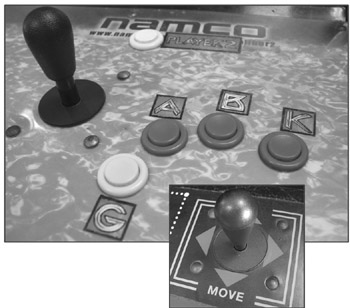
Figure 2.4: Procedures
For instance, if you wanted to create a set of four cards of like rank, you wouldn't necessarily ask one player at a time for these cards. You might use a more efficient means, like asking all of the players at once, or simply looking through the draw deck for the cards you needed. Because games, by their nature, have procedures that must be followed, you don't take these more efficient actions. Instead, you follow the procedures, and in doing so, you confirm that these required actions are indeed an important distinction that sets games apart from other behaviors and experiences.
Rules
Both descriptions spend a great deal of time explaining exactly what objects the game consists of and what the players can and cannot do. They also clarify what happens in various situations that might arise. In Go Fish, 'the cards are placed face down in a draw pile,' or 'if Chris has cards of the named rank, he must give me all his cards of this rank.' And from Quake, 'there are eight types of weapons,' and 'shells are for both types of shotguns, nails are for nailguns and perforators, etc.'
Some of these rule statements define game objects and concepts. Objects, like the deck of cards, draw pile, and weapons, are the building blocks of each of these systems, upon which the rest of the design depends. Other rules limit player behavior and proscribe reactive events. For instance, if nails are for nailguns, you can't use nails in the thunderbolt. If you have a Jack when you're asked for one, you have to give it up; you can't keep it, or you're breaking the rules of the game. Who will stop you from breaking the rules? Your own sense of fair play? The other players? The underlying code of a digital game?
The concepts of both rules and procedures imply authority, and yet there is no person or body named in either description with whom to associate that authority. The authority of the rules stems from an implicit agreement by the players to submit themselves to the experience. If you don't follow the rules, in a very real way, you are no longer playing the game.
So, our next distinctive quality of games is that they are experiences that have rules which define game objects, proscribe principles, and limit behavior within the game. These rules are respected because the players understand that they are a key structural element of the game, and without them, the game would not function.
Exercise 2.4: Rules
Can you think of a game which has no rules? I f so, describe it here. How about one rule? Why is this exercise difficult?
Resources
As we've discussed each of these games, we've mentioned certain objects that seem to hold a rather high value for the players in reaching their objectives. In Go Fish, the cards of each rank; and in Quake, the weapons, their ammunition, as well as the power-ups mentioned in the rule set. These objects, made valuable because they can help the players achieve their goal, but made scarce in the system by the designer, are what we call resources.

Figure 2.5: Rules
Finding and managing resources is a key part of many games-whether those resources are cards, weapons, time, units, turns, or terrain. In the two examples we see here, one depends on direct exchange of resources (Go Fish), while the other offers resources fixed in place by the game designer (Quake).
Resources are, by definition, items made valuable by their scarcity and utility. In the real world, and in game worlds, resources can be used to further our aims; they can be combined to make new products or items; and they can be bought and sold in various types of markets.
Conflict
As noted previously, both experiences we described lay out specific objectives for their players. And, as we've also noted, they lay out procedures and rules that guide and limit player behavior. The problem for the players is that the procedures and rules of games tend to deter them from accomplishing goals directly. For example, as mentioned earlier, you cannot simply ask everyone at the table to give you the other three Jacks all at once when you're playing Go Fish. You have to ask each player one at a time, risking that you may not get a card and lose your turn, while revealing to the table that you have a card of the rank you asked for.
Similarly, in Quake, if you could just leave the level of the complex you're on, that would solve the objective, but it's not that easy. To find the exit, you're forced to make it through a maze-like obstacle course of enemies and hazards. In both cases, the relationship between the objectives of the players and the rules limiting behavior creates another distinctive element of games: conflict, which the players work to resolve in their own favor.
Exercise 2.5: Conflict
Compare and contrast the conflict in football to the conflict in poker. Describe how each game creates conflict for the players.
Boundaries
Another similarity between these two experiences, one which is not referred to directly in either description but rather implied, is that the rules and goals that are driving the players apply only within the game and not in 'real life.' In the case of Quake, the architecture of the 3D space forms a physical boundary. Players are precluded from moving their characters out of these boundaries by the underlying code.
In the case of Go Fish, the boundaries are more conceptual than physical. Players are not precisely bounded in a physical sense by any of the rules, except that they need to be able to speak to one another and trade cards back and forth. They are, however, conceptually bounded by the social agreement that they are playing the game and that they will not leave the game with some of the cards, or add extra cards to the deck.
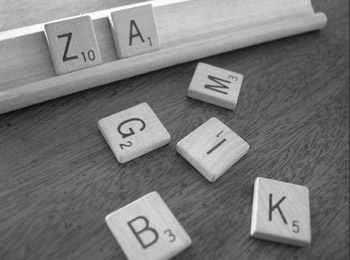
Figure 2.6: Resources
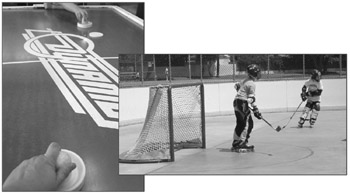
Figure 2.7: Conflict
The concept that these experiences are somehow set apart from other experiences by boundaries is yet another distinction we can make about the structure of games.
Outcome
One last similarity between both of these experiences is that they are both driving towards measurable and unequal outcomes. For example, in Go Fish, the player who achieves the objective of making the most books by the end of the game wins. In Quake, a player can either win (stay alive) or lose (be killed).
The outcome differs from the objective in that all players may achieve the objective, but other factors within the system may determine which of these actually win the game. For example, in Go Fish, a number of players may accomplish the objective of creating books, but only one player will create the most books-unless there's a tie, and that type of special case is usually addressed in the rules of a game.
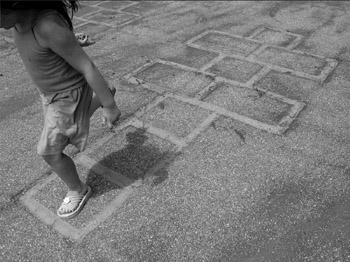
Figure 2.8: Boundaries
| Title | Project list (five to eight top projects) | |
| Creative Director, |
|
|
How did you get into the game industry?
Was working as an auto mechanic and living in Mesquite, Texas. It just so happened that one of my neighbors was John Carmack, owner of id Software. He and I became friends, and after several months of hanging out and beta testing at id, John offered me a job doing tech support. While answering phones I trained myself on the in-house design tools and quickly found myself creating content for DOOM II . The rest, as they say, is history.
What are your five favorite games and why?
The Legend of Zelda: The Ocarina of Time, Grand Theft Auto III, Battlefield 1942, Medal of Honor, etc. Games that deliver a sense of an endless world, living environments, and open-endedness always get my stamp of approval. I'm looking forward to the day when emergent gameplay takes us away from the idea of 'videogames' and into alternate realities where we decide what the gameplay is.
What games have inspired you the most as a designer and why?
Every game I play inspires me in some way. It could be an elegant solution to a third person auto-camera, or the worst driving physics ever created-even the mistakes have something to teach us.
What are you most proud of in your career?
Just being a part of the industry makes me proud. If you had asked me fifteen years ago where I'd be today I think that 'game designer' would have seemed just as unlikely as brain surgeon. All the other events that have transpired since my entry into the industry are gravy.
What words of advice would you give to an aspiring designer today?
Think entertainment, not games. The creative people within our industry need to start thinking about the big picture, not just the boxed game product. When you design, design with toys, books, films, soundtracks, clothing lines, and any other franchise extensions you can think of in mind. In addition to that, design these things for your audience, not for yourself or your team. Games are not about designer versus player any more, they're about your ideas versus the marketplace.
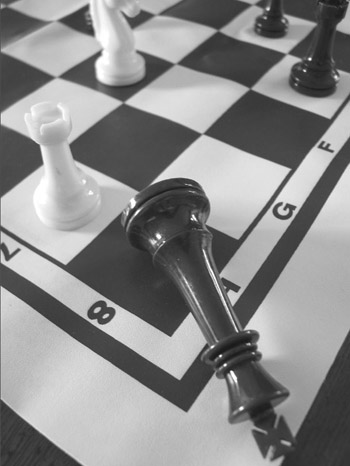
Figure 2.9: Outcome
We said in the introduction to this section that people play games to gain a sense of achievement. Outcome is often the measure of that achievement. Providing this sense of unequal outcome is a key element of the experiences we call games.
Formal Elements
The games you described in Exercise 2.1 may also have had other elements we haven't mentioned here: perhaps special equipment, digital environments, complex resources structures, or character definitions. And of course Go Fish and Quake each have their own unique elements that wehaven't touched upon, such as the turn structure in Go Fish or the real-time element of Quake. But what we're interested in right now are elements that all games share-elements that make up the essence of games.
A number of scholars from different fields have examined this same question from other perspectives. Some of the most influential have been those looking at games in terms of studying conflict, economics, behavioral psychology, sociology, and anthropology.
But our perspective is not strictly academic, and our purpose here is not to be definitive. Rather, it is to provide a useful context for us to discuss the process of designing games. The distinctive elements that we discussed starting on page 24 are important concepts for the game designer to understand because they provide structure (and form). Without these elements, a game would lose its 'gameness' and become some other activity.
Because they play an essential structural function, we call these the 'formal elements' of games. We will look at each of these formal elements in more detail in Chapter 3 and discuss how you can use them in various combinations to achieve exactly the type of gaming experience that you want to create for your players.
|
| < Day Day Up > |
|
EAN: 2147483647
Pages: 162